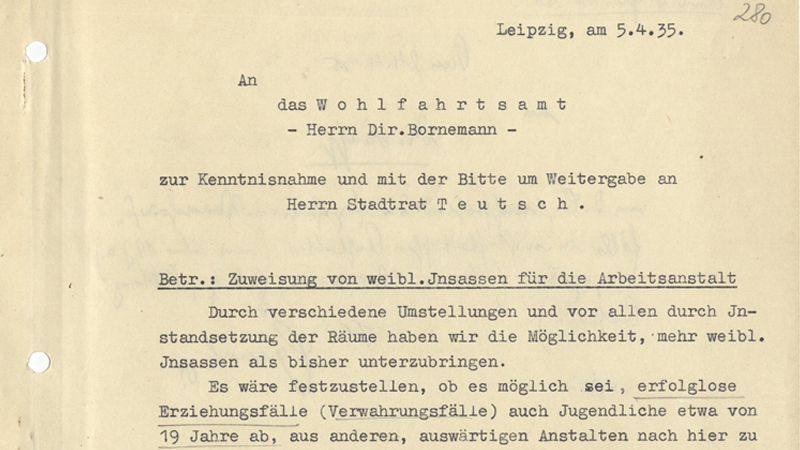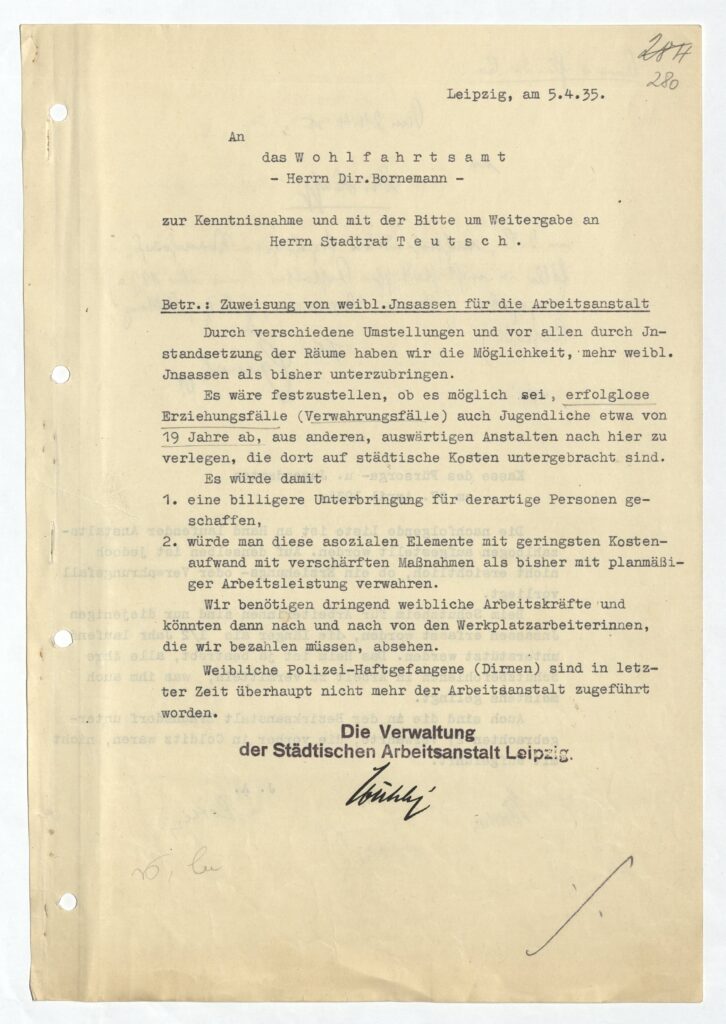
"Allocation of
females inmates to
the workhouse"
26 FEB 2021
After the NSDAP came to power in early 1933, the radicalization of social and health policies quickly affected Leipzig’s municipal workhouse. From 1934, it was run by the staunch National Socialist Georg Mühlig, and from 1935 the measures against the various groups interned in Riebeckstraße were drastically intensified. This was largely due to the collaboration of Fritz Teutsch, city councillor and head of the Welfare Office, and Walter Bornemann, director of the Welfare Office. The measures they pushed through led to more radical measures against the homeless.

The letter shown here, sent to Teutsch and Bornemann on April 5, 1935, by the chief inspector of the municipal workhouse, Georg Mühlig, should be seen in this context. Mühlig asks the higher authorities about the possibility of assigning female inmates to the workhouse. He suggested that “unsuccessful child-rearing cases (custody cases)”, who were housed in external institutions at the city’s expense, be transferred to Riebeckstraße. Custodial cases” or “custodians” were primarily people who were interned for an indefinite period by order of the guardianship court through the Welfare Office, the reason for which was “protection from physical or moral neglect,” according to a list published by the Welfare Office in early 1933. [1] Fittingly, Mühlig used the inhuman language of National Socialism when he spoke of “asocial elements” who were to be retained in Riebeckstraße.
In his letter, Mühlig gives various reasons for his request. First, he states that the prison has unused capacity to house female inmates. He assures that the accommodation will be cheaper than before, which would mean a reduction in costs for the city. He also holds out the prospect of more efficient use of labor as a result of the “tightened measures”. He also emphasized that the workhouse urgently needed female workers in order to be able to dispense with the “workplace workers” who had to be paid.
The Municipal Labor Institute’s request was therefore in no way aimed at improving the situation of the women and girls concerned. Rather, it was about the economic efficiency of the institution. On the one hand, the utilization of the places provided for the women and girls was to be guaranteed, since the institution received a lump sum per person from the higher authorities. Another goal was to exploit the labor of women and girls under the total control of the institution: women and girls from other institutions were to be interned in Riebeckstraße in order to replace cost-intensive external labor from the institution’s own work force.
This demand and its consequences clearly illustrate the nation socialist concept of welfare, according to which services should always be demanded in return. It also illustrates the early use of unpaid (forced) labor during the National Socialism, which not coincidentally took place in a place that was called the “St. Georg Forced Labor Institution” when it was founded in 1892.
This letter was followed by a list of more than 50 women and girls from various institutions in and around Leipzig who were being considered for transfer to the city’s workhouse. The list was drawn up by the Welfare and Youth Office on April 27, 1935. In the months that followed, there were numerous transfers after the respective institutions had checked the inmates’ suitability for work. In many cases, however, the transfers were not carried out, for example because the women were “physically weak” and therefore unsuitable as workers, according to a letter from the Leipzig-Schönefeld Welfare Office dated May 18, 1935.
Markus Streb
Footnotes
1. Stadtarchiv Leipzig, AFSA 1786, Bl. 12.
